Explore Controlled Environment Agriculture (CEA) – 2024 Indepth Insights
Controlled Environment Agriculture offers year-round crop production, resource efficiency, enhanced pest and disease management, and improved crop quality. These are some reasons why outdoor growers switch to indoor crop production in greenhouses. Learn more about controlled environment agriculture below, including available solutions to increase the profitability and production of greenhouses.
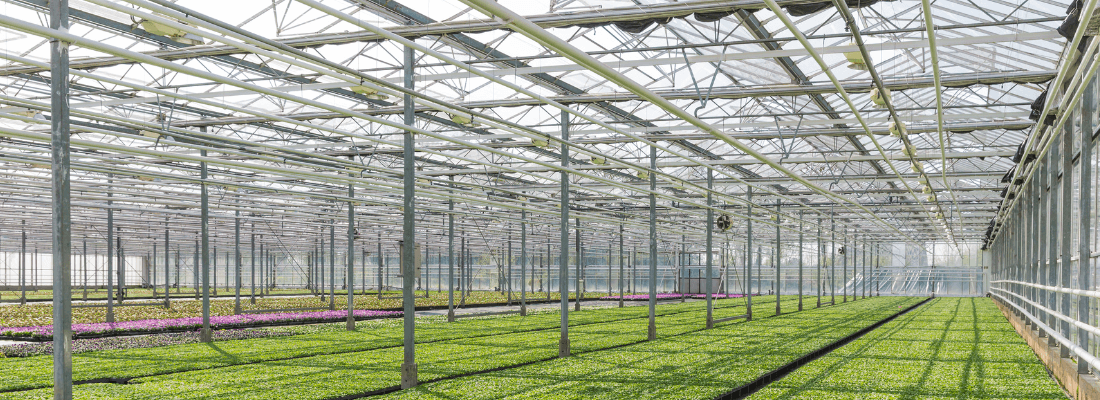
Table of contents:
- Table of contents:
- What is controlled environment agriculture
- Types of Controlled Environment Agriculture and ways of Indoor farming
- why Controlled Environment Agriculture?
- 6 Benefits of Controlled Environment Agriculture:
- What Types Of Crops Are Grown In CEA Systems (Indoor Controlled Environments)?
- What do you need for Controlled Environment Agriculture?
- The trends of CEA
- The challenges of Indoor farming
- solutions for CEA and CEA Services
- Types of Controlled Environment Agriculture:
- Dutch Indoor Controlled Environment Companies
- FAQ about Controlled Environment agriculture (CEA)
What is controlled environment agriculture
Controlled environment agriculture (CEA) is a way of farming which makes it possible to control the environment in which the crops are grown. The controlled environment definition relates to the fact that the way of indoor farming the crops are less dependent on the surrounding environmental conditions.
In the case of CEA, the crops are grown in a protected environment – this is the reason why controlled environment agriculture is also called “indoor farming” or “indoor agriculture”.
With Controlled Environment agriculture, the greenhouse grower has more control on the growing condition. Besides that, the amount of the input/resources that is needed to produce a certain amount of crop, can be predicted quite exactly at the beginning of the growing season.

-
The picture is showing cucumber plants growing in a high-tech greenhouse. This type of indoor farming enables year round production.
Types of Controlled Environment Agriculture and ways of Indoor farming
There are different types of indoor farming practices. The system is considered being “controlled environment agriculture”, when the crops that are being grown are in some way protected from the environment by a glasshouse or a plastic structure.
A CEA system can range from very simple (in the case that the crops are only covered by a plastic greenhouse structure (low-tech)), to more complex, such as growing crops in glass greenhouses with additional artificial lighting. The most protected type of indoor farming is when the crops are totally secluded from the environment and not dependent on any uncontrollable environment condition.

-
On the picture roses in a Dutch greenhouse can be seen. Producing high quality roses in heated greenhouses in the Netherlands is common.
The most advanced and most high-tech indoor farming system, is in a vertical farming setting. Here, the crops are illuminated with artificial lighting (often LED plant growth lights) and there is a total climate control. Each variable of the growing condition can then be controlled. Growing crops in a vertical farming setting is also the most expensive way of growing the plants, as the energy from the sun to drive photosynthesis is not directly used in this system.
A misconception exists regarding Controlled Environment Agriculture (CEA), wherein it is commonly assumed that crops are exclusively cultivated in vertical farms. However, this assumption is inaccurate. CEA is more than just producing crops in a vertical farm.
Within CEA agriculture, we define the indoor growing system as either low-tech, mid-tech or high-tech. The level of the ability to control the environment increases when you go from a low-tech CEA system to a mid-tech CEA system. With high-tech CEA system having the highest level of human/artificial control of the system.
why Controlled Environment Agriculture?
There are some important benefits of controlled environment to mention.
With the increasing unpredictable level of climate change effects on rainfall, temperature and extended periods of flooding and droughts, steady predictable amount of yields is harder to achieve.
In the next coming 50 years, the level of unpredictable weather conditions will only be increasing and the amount of farmable land in the world will decrease due to soil erosion and land degradation.
This is a concern, particularly in light of the projected global population reaching 9.3 billion by 2050. Ensuring universal access to an adequate food supply is regarded as a fundamental human right, making this issue particularly pressing.
One of the potential options to ensure food security and to meet future food demands worldwide is the usage of controlled environment agriculture.
Another challenge the world faces is that our current agricultural activities account for 21–37% of all greenhouse gas emissions each year (IPCC). Effectively and efficiently utilizing our natural resources while maintaining a low carbon footprint in agriculture is, therefore, crucial.
6 Benefits of Controlled Environment Agriculture:
1) Less dependence on outdoor environmental conditions
A major benefit of a controlled environment in agriculture is that the system is either semi-closed or completely closed. This means that the crops you are growing are less susceptible to external uncontrollable factors such as the amount of sunshine and rainfall.
Farming in a controlled environment makes the crops less dependent on the surrounding weather conditions. It then becomes possible to alter the climate and to create an optimum growing condition for the crops. The quantity of crop production will consequently increase as well.
2) Higher quality crops
The crops that are produced in a protected environment looks better and has less damage due to environmental condition or insects. This helps to sell the produce for a higher market price, and a premium can be asked for greenhouse crops.
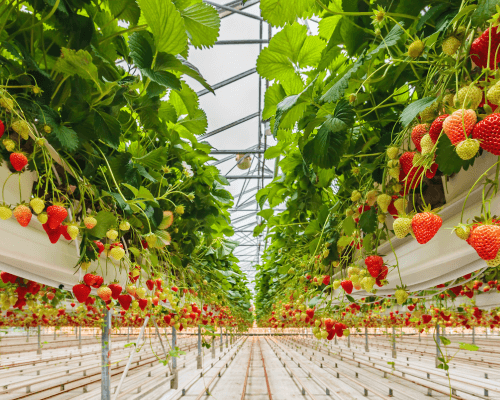
-
(For high quality indoor grown strawberries, the grower can ask more money for it)
3) Year round production becomes possible
With the right greenhouse equipments and greenhouse technologies, year round production will be possible; meaning more crops can be harvested per year and multiple growing cycles can take place.
If there is a demand or market for a particular crop, and increasing crop production throughout the year can enhance your revenues, then indoor farming should be seriously considered
4) Less exposure to pest & less pesticide usage
Another benefit of controlled environment agriculture that the crops are well protected from pests such as insects or plant associated diseases. The exposure of crops to pests in an indoor environment will also decrease, resulting in a significant reduction in the usage of chemical pesticides compared to conventional agriculture systems (outdoor production).
In an indoor environment, the usage of biological control systems is really effective. With biological control systems, natural enemies of a certain pest can be used to eliminate the pest. Little to no chemical pesticides are then needed, which is the case in the Netherlands for the vegetables grown in the commercial greenhouse. Some examples of biological control systems as part of integrated pest management used in the Netherlands:
Predatory Insects:
- Ladybugs (Hippodamia convergens): These beetles are natural predators of aphids and other soft-bodied pests.
- Predatory Mites (Phytoseiulus persimilis): They feed on harmful mites, helping control spider mite populations.
Parasitic Wasps:
- Encarsia formosa: This parasitic wasp targets whiteflies by laying its eggs on them. The emerging wasp larvae then feed on the whitefly nymphs.

5) Significant less nutrient and water usage
Nutrient and water usage will also significantly be lower. Especially when the crops are grown in a hydroponic system (soil-less system), nutrient water can be recycled en recirculated in the system.
Evapotranspiration of water (combination of evaporation + transpiration) stays in the greenhouse (In a plastic greenhouse to a lesser extent than in a glass greenhouse) and returns to the system by condensation.
There is limited evaporation from a closed hydroponic system, as there is nearly no open water service (nutrient water is transported through closed tubes). Therefore, less water to produce the same amount of produce (per kg) is needed comparing to outdoor crop production.
Nutrient loss out of the system will be minimized as well. The nutrient flowing in the system can be recycled until most of it is taken up by the plants (the nutrient water in a commercial greenhouse is sterilized after flowing through the system with UV light).
6) Desert agriculture and production on degraded soil become possible
With controlled environment agriculture combined with soil-less production (growing crops in a water nutrient solution), even desert agriculture or cultivation on degraded soil will be possible.
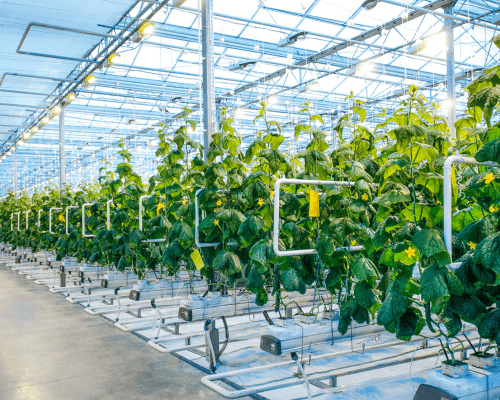
-
(Even in a desert, you can grow crops and produce food with commercial greenhouses. The climate in the greenhouse is artificially regulated with smart climate control computers, cooling elements (or heating elements) and humidifiers).
What Types Of Crops Are Grown In CEA Systems (Indoor Controlled Environments)?
Very often, crops grown in a controlled environment agriculture system are those that can be sold for a higher market price (cash crops) or crops that need to appear as “clean.” Some examples of greenhouse horticulture crops include:
- Lettuce
- Tomatoes
- Bell pepper
- Strawberries
- Medicinal Cannabis
Some other major products of controlled environment agriculture, of which many consumers are not aware, include mushrooms, insects (for protein production), and fish (aquaponics).
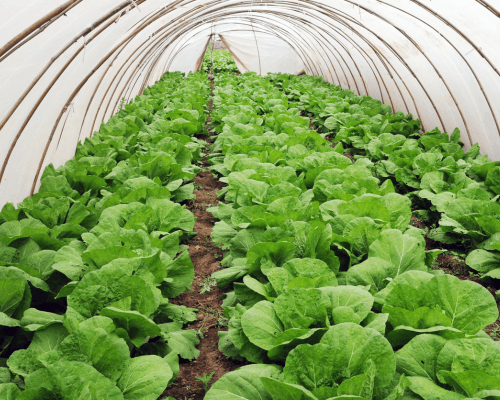
-
An example of a plastic tunnel where leafy greens are grown.
What do you need for Controlled Environment Agriculture?
With CEA, climate control farming is an important element. The highest yields are associated with large-scale, high-tech commercial operations primarily located in northwestern Europe, Canada, and Australia. Production in plastic greenhouses using more traditional methods, small-scale operations, and/or soil cultivation results in lower yields.
High-tech greenhouses are made of steel and covered with glass, equipped with complex climate control systems for heating, cooling, humidity and lighting.
To create a better and more optimal growing condition for the crops than outdoor conditions, the following elements are crucial, especially when there is interest for mid-tech or high-tech greenhouse crop production:
- Covering material (plastic or glass)
- Artificial lighting (supplemental lighting)
- Heating elements / cooling elements
- Growing substrate (soil less production)
- Nutrient solution (soil less production)
- Additional CO2 injection
- Climate computer / climate control system
The shift from growing crops on soil in a greenhouse without heating to growing crops in a nutrient solution with heating in a greenhouse, will increase the controllability of the indoor growing system and yield.
When looking at tomatoes in heated commercial greenhouses, the yield varies from around 16 to 70 kg/m2, while in unheated greenhouses, the yields range from 11 to 25 kg/m2.

-
(Growing vine tomatoes in an advanced greenhouse. With the right greenhouse technologies and knowledge, high production can be achieved).
The trends of CEA
Greenhouses worldwide and proportion:
Currently, a large amount of the greenhouses worldwide are considered being low-tech. Looking globally, there is 500,000 hectares of land dedicated to protected horticulture (TopsectorTU, 2022).
Among these, 75,000 hectares comprise high-tech greenhouses (15%), with a smaller portion of a few hundred hectares dedicated to Indoor/vertical Farming. Meaning 85% of protected agriculture worldwide is either low-tech or mid-tech. We know that low-tech CEA are plastic tunnels covering the crops. Crops growing in plastic tunnels are only to a small extent protected from the outdoor environment.
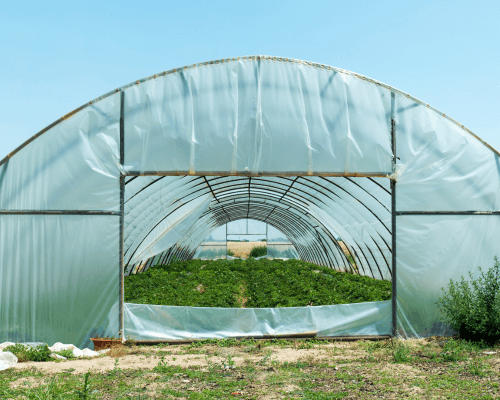
-
(An example of a low-tech greenhouse. Usually, this type of greenhouse is installed in warm countries. The tunnels are open, so there is natural ventilation).
Government Investment for local Food Security:
With the view of food security, more governments are investing more in greenhouse horticulture. To produce and provide enough food (vegetables) in their own country without being largely dependent on their neighboring countries for food import.
One of the expectations and trends of CEA is that more low-tech and mid-tech greenhouses will start to implement more greenhouse technologies to optimize their productions. The primary goal of controlled environment agriculture has been and will still be focussing on attaining maximum crop yield and produce high-quality fruits while minimizing costs.
Technological Advancements in CEA:
Advancements in affordable and energy-efficient sensors, improvements in decision-making computer models with artificial intelligence, mobile applications, combined with existing crop simulation models, and better horticultural engineering to build more suitable greenhouses in complex environments are helping the horticulture industry produce better.
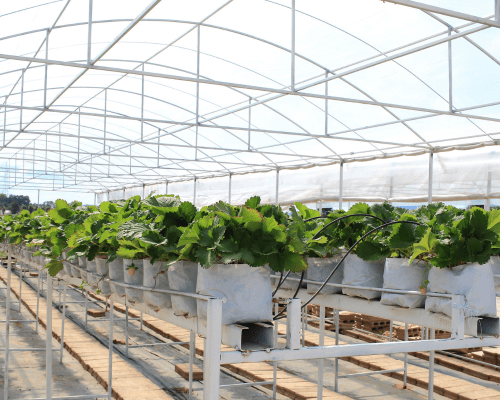
Technological Innovations in Greenhouse Production:
Europe pioneered in greenhouse horticulture and in the future, it will definitely still maintain its leading position in the usage and area coverage of (high-tech) greenhouses. Same with having a thriving cluster of innovative companies and institutions steering this industry.
CEA growth opportunities worldwide:
Besides great growth opportunities and rapid expansion of Controlled Environment Agriculture CEA in the European continent, it is expected that in the coming next years till (and after) 2050, we will see a sign of significant growth opportunities in North America and Asia too.
For high-tech greenhouse expansion, France, Germany, Poland, Morocco, Turkey, USA, Canada, the Gulf region, China, Japan, Uzbekistan, and Kazakhstan emerge as important countries for the next coming years.
Increasing interests in advanced CEA in Asia:
In Asian countries, where most vegetables are grown under low-tech greenhouses, there will be a steep growth in mid-tech greenhouse expansion. This is driven by the increasing demand for high-quality vegetables from the middle class, who are both able and willing to pay more for good-quality food.
How fast CEA will grow and where new greenhouses will be built, highly depends on the local considerations involving the availability of water, energy, proximity to markets, labor, and capital.
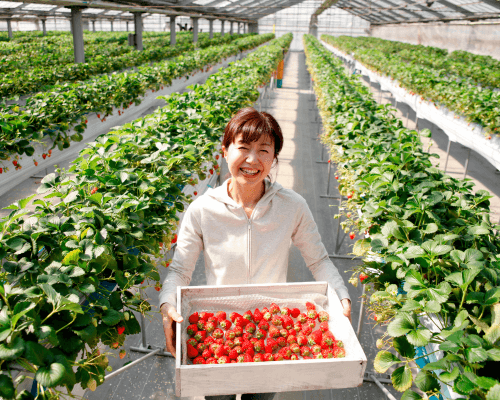
-
On the picture, a japanese strawberry grower can be seen. Greenhouses are more being used world wide. Farmers and companies are investing in building greenhouses globally.
Potentials for low-tech and mid-tech greenhouses worldwide:
Low-tech and mid-tech greenhouses can improve themselves significantly with improvements such as reducing nutrient leakage out of the ‘greenhouse’ system. This could be for example done by recycling the drain water and re-use the nutrient solution after disinfecting it with UV lights.
Also, significant less chemical pesticides can be used when an integrated pest management approach is considered in low-tech and mid-tech CEA. This is an approach where pest management is not solely performed by spraying pesticides, but also implementing biological control elements with natural enemies and installing insect traps (sticky traps)
Increasing Vertical Farm energy efficiency can lead to growth:
If energy efficiency for producing crops in a vertical farming setting can be increased and operational costs can be lowered, this particular area of indoor farming will grow significantly as well.
The challenges of Indoor farming
Besides the benefits of a CEA system, there are also some limitation of a controlled environment agriculture system
1) Not Feasible to grow Important calorie crops / staple crops
A major limitation of indoor agriculture is that, for essential calorie crops such as wheat and maize, it is not economically feasible to cultivate them indoors in a protected environment.
The market value for these calorie crops is too low, even though the yield of these crops in an indoor setting is much higher compared to outdoor cultivation. It is also not realistically to build greenhouses covering most of our agricultural land worldwide.
2) High usage of energy & extra CO2 emission
Another disadvantages of protected cultivation of crops is the usage of energy and CO2 emission. In controlled environment agriculture, the greenhouse or the growing chamber (of a vertical farm) is often either heated or cooled with energy generated by natural gas/another source of non-renewable energy sources. This has large impacts on the environment, which should not be neglected.
With the usage of renewable energy and implementation of certain greenhouse technologies (such as a smart climate control system which only applies lightning when needed), it is possible to reduce its environmental impact.
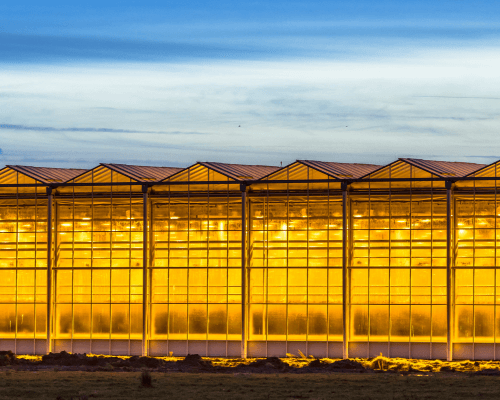
-
(Working on increasing the energy use efficiency in Dutch greenhouses, is one of the topics the Dutch greenhouse sector is working on. Quite some greenhouses in the Netherlands are powered by geothermal energy to heat up the greenhouses here).
solutions for CEA and CEA Services
Controlled Environment Agriculture (CEA) needs to meet the growing demand for high-quality produce while facing the responsibility of using natural resources / energy responsibly.
In response to these big challenges, innovative greenhouse solutions have emerged in the Netherlands to increase the efficiency and sustainability of CEA practices.
1) Implementation of greenhouse technologies
Technological integration, such as sensor technologies (for measuring the growing conditions in the greenhouse) and automation systems (such as applying artificial lighting only when it is necessarily), plays an important role in optimizing resource utilization in the greenhouse. In controlled environment agriculture, using a greenhouse climate computer is important as it helps to increase the work efficiency of growers and while also helping them to make better decisions based on collected data.

2) Using data to make decisions
Data-driven decision-making, powered by artificial intelligence and machine learning, is helping greenhouse growers to make better and informed choices for crop management. The integration of the Internet of Things (IoT) enhances real-time monitoring of the situation in greenhouses, which is being applied more often.
3) Using alternative energy sources such as geothermal energy in greenhouses
Sustainable practices, including using geothermal energy and other renewable energy to heat up the greenhouse in the winter, growing with less or no heating in the winter and better management strategies, contribute to reducing the environmental footprint of CEA.
Reducing the carbon footprint of CEA is and will still be a very important item in the near future.
Types of Controlled Environment Agriculture:
What is Low-Tech Greenhouse agriculture?
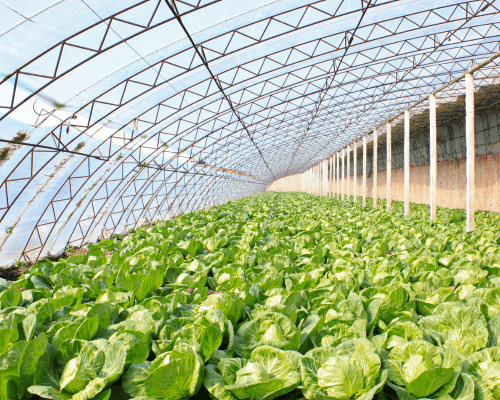
An example of a low-tech greenhouse. The wall on the right warms up during the day and releases heat in the greenhouse in the evening. Low tech greenhouses are often covered by plastic and there are openings in the tunnels for airflow.
A low-tech greenhouse is a simplified structure designed for basic horticultural needs. It typically features natural ventilation and relies on manual controls. While cost-effective (it is not so expensive to build a low-tech greenhouse), it offers limited automation and environmental control compared to more advanced options.
Also, the protection layer of a low-tech greenhouse is made from plastic. This needs to be changed quite often and year-round prodution is not guaranteed.
This type of controlled environment farming system is normally found in tropical or warm area’s in the world (Asia or Africa).
The production is the lowest in a low-tech indoor farming setting, compared to mid- or high-tech indoor farming.
Some challenges related to low-tech greenhouses:
- Inconsistent
product quality - Higher distribution costs
- Less-experienced
management - Less-developed infrastructure
- Lower Energy Use Efficiency
What is Mid-Tech Greenhouse Agriculture?

An example of a mid-tech greenhouse. The strawberries are growing in bags with automated drip-irrigation.
A mid-tech greenhouse incorporates moderate automation and environmental control systems. It may include technologies such as automated ventilation, basic climate control, and irrigation. Sometimes, artificial lightning (supplementary lightning) is also present.
This level of technology enhances efficiency and crop management without the complexity of high-tech solutions.
The crops growing in a mid-tech greenhouses look better compared to low-tech greenhouses. Also, there are less issues with pests. However, the level of automation can still be increases (not manually turning lights on and off) which can save labor costs.
What is High-Tech Greenhouse agriculture?
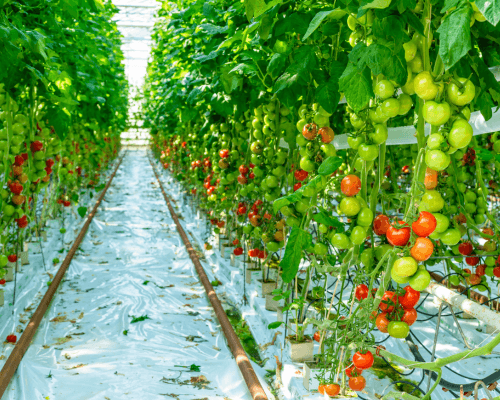
An example of a high tech greenhouse where tomatoes are grown. In these modern greenhouses, automated process help the growers to produce better crops. Also, a lot of decisions are made based on data.
High-tech greenhouses are equipped with advanced technologies for precise environmental control. Also, (active) heating and cooling elements are present.
Automated systems regulate temperature, lighting, humidity, irrigation, and nutrient delivery (through a hydroponic system). There is often also a nutrient water disinfection system with UV lights to clean the drain water.
With high-tech Greenhouse agriculture, it is possible to grow without chemical pesticides. In these modern high-tech greenhouses, natural enemies of the pests (e.g. insects) are used to control the pest population.
Large scale automated greenhouses with seeding machines or harvesting machines (in the case of growing lettuces) can be installed in high-tech greenhouses.
In this type of greenhouse, there are sensors and computerized management to optimize growing conditions (data-driven method to make good decisions). This leads to enhanced crop yield, quality, and resource efficiency.
Most high-tech greenhouses worldwide can be found in European countries (the greenhouse industry is well developed in the Netherlands) and in Canada.
Description of Indoor Farming with vertical farming:

Vertical grow systems, like growing crops in a vertical farming setting, use multiple farming technologies to increase the overall yield per growing area. Crops are then being grown in a very clean environment with often no need of pesticides at all. Growing leafy greens (which has a very short growing cycle) is one of the most profitable crops to grow in a vertical farm.
Vertical farming involves growing crops without any sunlight at all, but uses artificial plant growth lighting such as LED lights to illuminate the crops. The crops are often stacked in layers (like warehouse shelves) or vertically inclined surfaces.
The indoor environment in a vertical farming setting, is nearly 100% controllable. This is done with advanced greenhouse technologies, including LED lighting, hydroponic or aeroponic systems, climate control with healting/cooling elements. People walk around in clean suits to prevent the spread of plant diseases.
Unlike traditional high-tech greenhouses, vertical farming tries to maximize space by growing crops vertically, above one another. More crops can be harvested per ground area in a vertical farming setting.
Also, in traditional high-tech greenhouses, sunlight is still used to drive plant photosynthesis. But in a vertical farming setting, the only light source for the plants come from lights.
Increasing the energy use efficiency in greenhouses is one of the important topics to work on to increase the long term profitability of vertical farms.
Dutch Indoor Controlled Environment Companies
The Netherlands has been a global leader in agricultural innovation and controlled environment agriculture (CEA). Dutch companies have played a significant role in the development and promotion of indoor farming technologies worldwide. These companies leverage the expertise gained from the country’s long-standing tradition in horticulture and greenhouse cultivation.
The area’s that the Dutch indoor controlled environment companies are involved in, is categorized below:
- Greenhouse Construction and Technology
- Climate Control and Automation
- Horticultural Lighting
- Substrate Solutions
- Sustainable and Automated Solutions
- Logistics and Automation
- Research and Collaboration/Development
- Biological Pest Control and Pollination
- Turnkey Indoor Farming Solutions

